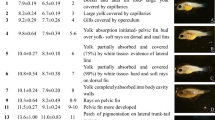Abstract
Veliger larvae of the oysterCrassostrea gigas (Thunberg) responded to unknown dissolved chemical inducers found in supernatants of cultures of the bacteriaAlteromonas colwelliana andVibrio cholerae. The response, which was similar to that seen when larvae were exposed to the neurotransmitter precursor L-3,4-dihydroxyphenylalanine (L-DOPA), consisted of an initial settlement phase of swimming with the foot extended and crawling on the substrate. Subsequently larvae attached to the substrate and metamorphosed. The percentage of veligers metamorphosing following inducation of settlement behavior was higher in a group of older larvae, a response similar to that seen with L-DOPA, suggesting that competence to respond to bacterial supernatants is divided into two phases: behavioral competence followed by morphogenetic competence. Following size exclusion chromatography, the molecular weight of the peak containing the activity which induced settlement behavior was determined to be ≤ 300 daltons. Autoclaved Marine Broth, which induced low levels of settlement behavior also contained this low molecular weight active peak, suggesting that an oyster settlement inducer is also present in this medium.
Similar content being viewed by others
Literature cited
Bonar, D. B., Weiner, R. M., Colwell, R. R. (1986). Microbial-invertebrate interactions and potential for biotechnology. Microb. Ecol. 12: 101–110
Burke, R. D. (1983). The induction of metamorphosis of marine invertebrate larvae: stimulus and response. Can. J. Zool. 61: 1701–1719
Coon, S. L., Bonar, D. B., Weiner, R. M. (1985). Induction of settlement and metamorphosis of the Pacific oyster,Crassostrea gigas (Thunberg), by L-DOPA and catecholamines. J. exp. mar. Biol. Ecol. 94: 211–221
Coon, S. L., Fitt, W. K., Bonar, D. B. (1990). Competence and delay of metamorphosis in the Pacific oyster,Crassostrea gigas (Thunberg). Mar. Biol. 106: 379–387
Crisp, D. J. (1974). Factors influencing the settlement of marine invertebrate larvae. In: Grant, P. T., Mackie, A. M. (eds.) Chemoreception in marine organisms. Academic Press, London, p. 177–265
Fitt, W. K., Labare, M. P., Fuqua, W. C., Walch, M., Coon, S. L., Bonar, D. B., Colwell, R. R., Weiner, R. M. (1989). Factors influencing bactreial production of inducers of settlement behavior of larvae of the oysterCrassostrea gigas. Microb. Ecol. 17: 287–298
Hadfield, M. G. (1984). Settlement requirements of molluscan larvae: new data on chemical and genetic roles. Aquaculture, Amsterdam, 39: 283–298
Hadfield, M. G. (1986). Settlement and recruitment of marine invertebrates: a perspective and some proposals. Bull. mar. Sci. 39: 418–425
Hadfield, M. G., Scheuer, D. (1985). Evidence for a soluble metamorphic inducer inPhestilla: ecological, chemical and biological data. Bull. mar. Sci. 37: 556–566
Hirata, K. Y., Hadfield, M. G. (1986). The role of choline in metamorphic induction ofPhestilla (Gastropoda, Nudibranchia). Comp. Biochem. Physiol. 84C: 15–21
Hofmann, D. K., Brand, U. (1987). Induction of metamorphosis in the symbiotic scyphozoanCassiopea andromeda: Role of marine bacteria and of biochemicals. Symbiosis 4: 99–116
Kirchman, D., Graham, S., Reish, D., Mitchell, R. (1982). Bacteria induce settlement and metamorphosis ofJanua (Dexiospira) brasiliensis Grube (Polychaeta: Spirorbidae). J. exp. mar. Biol. Ecol. 56: 153–163
Meadows, P. S., Campbell, J. I. 81972). Habitat selection by aquatic invertebrates. Adv. mar. Biol. 10: 271–382
Morse, D. E. (1985). Neurotransmitter-mimetic inducers of larval settlement and metamorphosis. Bull. mar. Sci. 37: 697–706
Müller, W. A. (1973). Induction of metamorphosis by bacteria and ions in the planulae ofHydractinia echinata; an approach to the mode of action. Publs Seto mar. biol. Lab. 20: 195–208
Neumann, R. (1979). Bacterial induction of settlement and metamorphosis in the planula larvae ofCassiopea andromeda (Cnidaria: Scyphozoa, Rhizostomeae). Mar. Ecol. Prog. Ser. 1: 21–28
Nicolaus, R. A. (1968). Melanins. Hermann Press, Paris
Pechenik, J. A. (1984). The relationship between temperature, growth rate, and duration of planktonic life for larvae of the gastropodCrepidula fornicata (L.). J. exp. mar. Biol. Ecol. 74: 241–257
Scheltema, R. S. (1974). Biological interactions determining larval settlement of marine invertebrates. Thalassia jugosl. 10: 263–296
Trapido-Rosenthal, H. G., Morse, D. E. (1985). L-α,ω-diamino acids facilitate GABA induction of larval metamorphosis in a gastropod mollusc (Haliotis rufescens). J. comp. Physiol. B 155: 403–414
Trapido-Rosenthal, H. G., Morse, D. E. (1986). Regulation of receptor-mediated settlement and metamorphosis in larvae of a gastropod mollusc (Haliotis rufescens). Bull. mar. Sci 39: 383–392
Walch, M., Labare, M. P., Weiner, R. M., Colwell, R. R., Fitt, W., Bonar, D. B. (1987). Use of specific bacterial biofilms and their products to enhance spat set of the oystersCrassostrea virginica andC. gigas. J. Shellfish Res. 7: 179–180
Weiner, R. M., Segall, A. M., Colwell, R. R. (1985). Characterization of a marine bacterium associated withCrassostrea virginica (the Eastern Oyster). Appl. envirol. Microbiol. 49: 83–90
Weiner, R. M., Coyne, V. E., Brayton, P., West, P., Raiken, S. F. (1988).Alteromonas colwelliana sp. nov., an isolate from oyster habitats. Int. J. system. Bact. 38: 240–244
Author information
Authors and Affiliations
Additional information
Communicated by J. Grassle, Woods Hole
Contribution # 137 from the Center of Biotechnology, Marine Biotechnology Institute, University of Maryland, USA
Rights and permissions
About this article
Cite this article
Fitt, W.K., Coon, S.L., Walch, M. et al. Settlement behavior and metamorphosis of oyster larvae (Crassostrea gigas) in response to bacterial supernatants. Mar. Biol. 106, 389–394 (1990). https://doi.org/10.1007/BF01344317
Accepted:
Issue Date:
DOI: https://doi.org/10.1007/BF01344317




